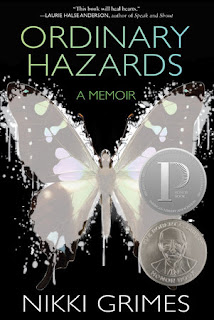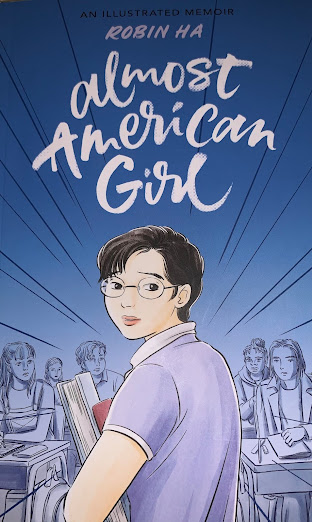Ordinary Hazards
Ordinary Hazards by Nikki Grimes
Photo Credit: Penguin Random House
Review:
Trigger Warning: This book contains mental illness, alcoholism, sexual assault and abuse.
Nikki Grimes’ memoir Ordinary Hazards is a deeply personal
collection of poems that explore the best and worst that her childhood had to
offer. Starting at the age of six, Grimes uses her poems as tools to question
time and memory. The narrative follows Grimes as she grows up, fighting her way
through the foster care system, abuse she’s experienced and the toll of taking
care of her mother who is schizophrenic. But through every life phase, Grimes
uses her narrator voice – her adult self – to break the book into fractions and
remind readers that although this is a story, it is not perfect and cohesive.
This novel is a personal reflection, but even though Grimes is talking about
herself, any young reader who is struggling through growing up can find
something to hold onto in this book, whether it’s her faith, her resiliency in
the face of adversity or the candidness that helps her heal.
She uses direct address to break down the barriers between herself
and the reader, consistently reminding them that although she is sharing her
life story, there are some parts that she cannot give to us because she simply
doesn’t remember, and that’s okay. Or in some cases, she explicitly tells
readers that she withholds information, such as her name. In those moments, she
establishes power and control to give herself agency over the story she wants
to tell.
She shapes memory as a fallible concept. It is not romanticized or
crystal clear. It is fractured and broken and inconsistent, but despite that,
she emphasizes that it’s important to hold onto memories for the part that they
play in shaping who we are. This is important for young adult readers because
it encourages them to confront their memories, no matter how dark, scary or
intimidating the past may seem. Grimes creates an inclusive space to show
readers that despite all that she has experienced, there is hope in darkness,
and even alongside the traumatic topics, there is a lightness that every person
can hold onto even after the last poem comes to a close.
Alongside her poems, Grimes also provides readers with notebook entries from her childhood self. These breaks between the verses act as windows into Grimes’ young mind as she struggles to work through complex questions like why is she experiencing trauma? Why didn’t her family members help when her mom left? And how can she begin to work through her own feelings of anger and resentment? These moments feel much more intimate because not only are they coming from the perspective of a child, but they break the poetry format and present as traditional paragraphs, as though her younger self was so focused on getting her thoughts on paper, that she didn’t care to organize them as thoughtfully as she does her poems. The distinction between the careful poems and the stream of consciousness notebook entries illustrates two different maturity levels – the difference between a young writer who uses her as words as a coping mechanism and an adult writer who molds her words with more precision after taking time to carefully process and identity her emotions. The two voices work in harmony throughout the story to showcase Grimes’ personal development and growth, almost as if the interaction between them is a conversation that completes the narrative with shared pieces of memory and fractured thoughts between childhood and adulthood.
Young readers should be cautious about the trigger warnings in this book because Grimes is not afraid to confront her reality, and that often translates into graphic depictions of emotional topics including mental illness and sexual assault. However, for readers who choose to experience Grimes’ story alongside her, the lightness, optimism and faith in the face of what seems like endless adversity is uplifting and inspirational for anyone who wants to believe that things will always get better.
Author Bio:
Photo credit: Aaron Lemen
Born on October 20, 1950 in Harlem, Nikki Grimes grew up living in and out of New York foster homes, constantly being moved around every six months to a year. This meant meeting new people, having to make new friends, saying goodbyes and having to completely start over on a regular basis. And as has been known to happen in the foster care system, she was separated from her sister. When not in foster homes though, her childhood did not get any easier. Her father was in and out of the picture, and her mother was a paranoid schizophrenic who was also in and out as well with frequent stays at hospitals. This meant a lot of loneliness and an extremely difficult childhood for a young Grimes. But, at the age of 6, it was in one of these foster homes that she wrote her first poem.
From there, she continued to write, winning her first writing award in the eighth grade and began publishing her first poems in high school. Now, she has gone on to become a bestselling author, having written many award-winning books for young adults and children. According to Grimes herself, the subject matter of these books is heavily influenced by her experiences in her childhood. As a young reader, Grimes scoured through entire libraries searching for someone in them who looked like her and shared her same experiences. Only rarely did she find herself in books, leaving her to feel invalidated and invisible. So, Grimes now endeavors to create books for children who, like she once was, are in dark places at no fault of their own and need that experience to be acknowledged and validated.
Instructional Resources:
1. Schizophrenia: The National Institute of Mental Health has a page dedicated to Schizophrenia. This page provides a general overview of schizophrenia including common onsets, symptoms, and treatments. Because Nikki’s mother suffers from schizophrenia, I think it’s important that one understands all of its implications. While Nikki did her best to describe it, she’s only a child during the time in which the story takes place. This page will no doubt be useful when it comes to understanding Nikki’s predicament.
2. Nikki Grimes Interview: This YouTube video is of an interview done with Nikki Grimes. In it, she discusses her difficult childhood, her writing ideologies, multicultural books, and many other topics. This interview can be helpful when reading Ordinary Hazards as it allows you to build a connection with the author.
3. Foster Care Through the Eyes of a Child: This Youtube video has Michelle Voorhees share her own experiences within the foster care system. She talks about the constant change and the inability to develop genuine trust with the people around her. Michelle’s Voorhees’ experience is helpful in understanding Ordinary Hazards because of the similarities between her and Nikki’s upbringing.
4. Sexual Assault Survivor Stories: Rainn is America’s largest anti-sexual assault organization. Their website has various pages regarding sexual-assault with one page documenting the stories of those who have survived sexual assault. This page is particularly useful as it documents the stories of all people without regards to gender, sexuality, ethnicity etc. This source can help someone better understand the lost-lasting trauma of those who’ve been sexually assaulted like Nikki.
5. A Daughter’s Search to Understand Her Mother’s Schizophrenia: Grimes’ story of a mother with schizophrenia and childhood trauma is unfortunately not the only one of its kind. Along with gathering information on Grimes herself, expanding research into other stories is critical as well. Grace M. Cho writes her story about dealing with mental illness in a parental figure, as well as her struggles with racism and family trauma. It’s not identical to Grimes’, but it’s another perspective in understanding how these things develop.
6. How Childhood Trauma Affects Us As Adults: This resource leans more into the scientific side. It examines trauma in a broad lens to understand possible impacts in how it lingers in adulthood. For topics like those that Grimes’ discusses, it’s critical to examine not only how it impacts her as a child but as an adult, relating to how trauma is not always temporary.
7. Memoir and Autobiography: Dealing with terminology, studying the form of writing is often helpful in expanding one’s knowledge of literary works. This resource will better aid students in digesting the difference between a memoir and autobiography, as both terms tend to be used interchangeably. Studying this distinction will allow a firmer grasp of literary genres.
8. Speak on It - Nikki Grimes: Hearing a poet speak is just as impactful as reading the words on the page. Grimes addresses several topics in this video, which can be used to not only contextualize the novel but also in hearing her own writing tips and inspiration. It is always beneficial to hear an author’s best advice and her story. If not the whole video, a piece of it could be used as a resource for this topic.
Instructional Activity:
Preview:
For this instructional activity, students will be practicing their narrative and poetic writing skills. Since Ordinary Hazards is a memoir-in-verse, students will be mimicking this format over their week or two of reading the novel in this assignment in order to gain a better appreciation for the nuanced differences between prose and poetry.
Warm-Up Activity:
Introduce students to the memoir’s opening definition of a memoir, that of “a work of imperfect memory in which you meticulously capture all you can recall, and used informed imagination to fill in what remains.” Group students into small groups of 3-4 students, and have them discuss for 5-10 minutes this definition of memoir and the overall format of a memoir. Some possible questions to consider are:
- What
makes a memoir a memoir? How does it differ from a biography? An
autobiography? In what ways do they differ from a fictional novel?
Refer students to sources such as the Memoir and Autobiography resource above for
further exploration of these terms.
- What
do you think the term “informed imagination” means, and how might that
relate to the process of writing a memoir?
- Have
you ever read a memoir before? Who or what was it about?
- Memory is often compared to a computer or filing system, where information is stored away into the brain (or computer) to be retrieved at a later date? How is memory “imperfect,” and have you read any previous stories that touched upon the unreliability of memory?
The Main Activity:
For this activity, after introducing the novel, tell students that they will have to write 2 to 3 pages about their lives in class today. These mini-memoirs should be as full of detail as possible. Give students a majority of the class period to complete this in-class writing assignment. It will be the basis of the week’s activities in class as they read through Ordinary Hazards. At the end of the writing, collect each student’s paper, and tell them they will be transforming their mini-memoir into a series of poems, just like Nikki Grimes does in her memoir written in verse. At the start of each class period, pass out the students’ papers (or have them already out on their desks) and have them write a short, one page poem about a particular event in their mini-memoir. Alternatively, if you are pressed for time, this assignment can be assigned as a homework assignment.
If you would like, we recommend expanding this assignment and incorporating it into a unit on poetry and various poetic forms. Students can be required to match the structure of a sonnet, a haiku, or a villanelle, for instance, in order to expand their poetic knowledge. Discussion of the poetic devices Grimes’ uses in the memoir, such as blank verse, free verse, enjambment, etc. can be incorporated into the discussion around the novel as well.
Cumulative Assessment:
After students complete the memoir, allow students to select their favorite poem, and rewrite the narrative of that poem as a one-to-two-page prose narrative, moving from poetry to prose as opposed to the prose-to-poem activity they have been completing all week long. Then, have students complete a short one-to-two-page reflection upon the different effects of verse compared to prose, the relative strengths and weaknesses of both methods, and why an author might choose to write a narrative in one form compared to the other. Make sure they include examples from Nikki Grimes’ poetry as supporting evidence.
Common Core Standards:
Reading Literature Grades 11-12
Analyze the impact of the author's choices regarding how to develop and relate elements of a story or drama (e.g., where a story is set, how the action is ordered, how the characters are introduced and developed).
Analyze how an author's choices concerning how to structure specific parts of a text (e.g., the choice of where to begin or end a story, the choice to provide a comedic or tragic resolution) contribute to its overall structure and meaning as well as its aesthetic impact.
Writing Grades 11-12
Write narratives to develop real or imagined experiences or events using effective technique, well-chosen details, and well-structured event sequences.
Write routinely over extended time frames (time for research, reflection, and revision) and shorter time frames (a single sitting or a day or two) for a range of tasks, purposes, and audiences.
Bibliography:
“Schizophrenia.” National Institute of Mental Health, May 2020,
“Taken into foster care, through the eyes of a child.” YouTube, uploaded by Kansas City Star,


